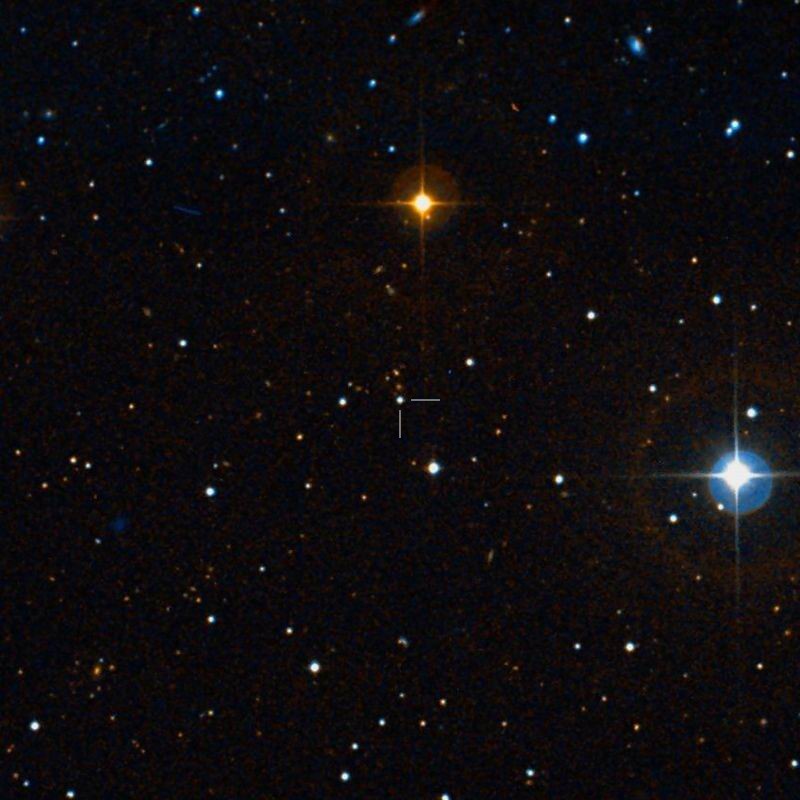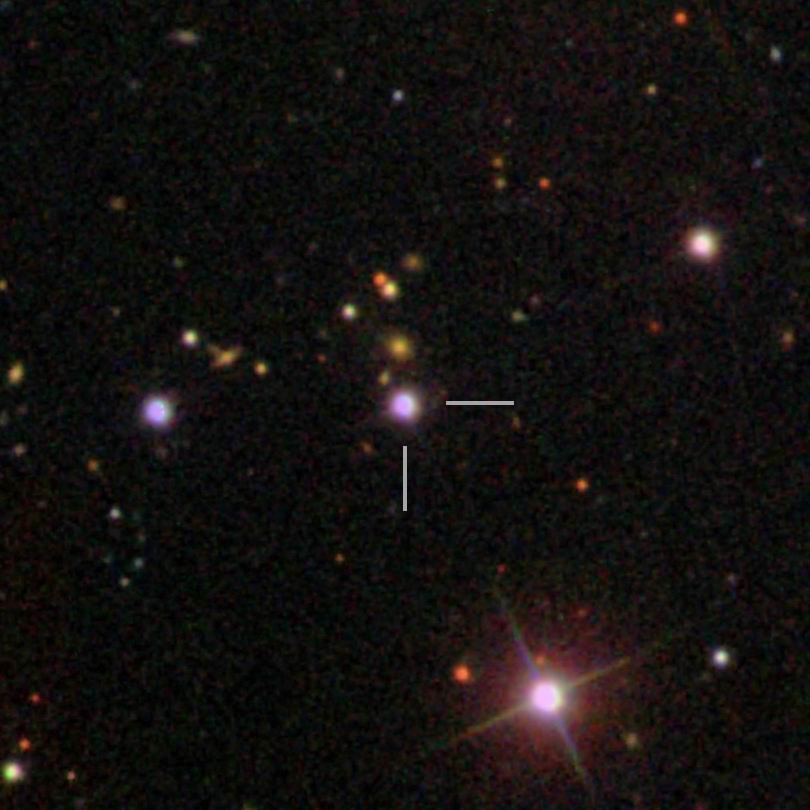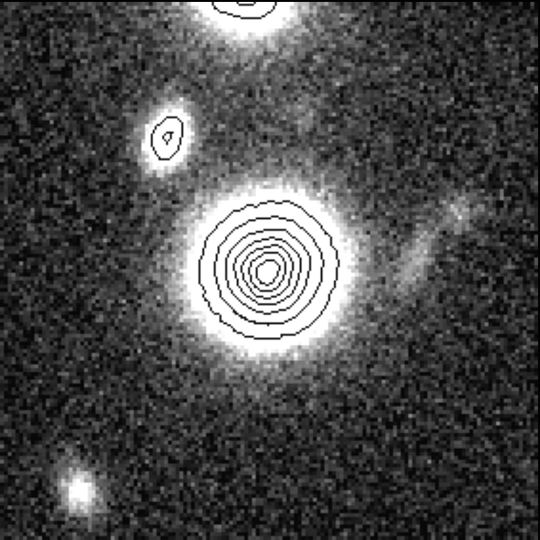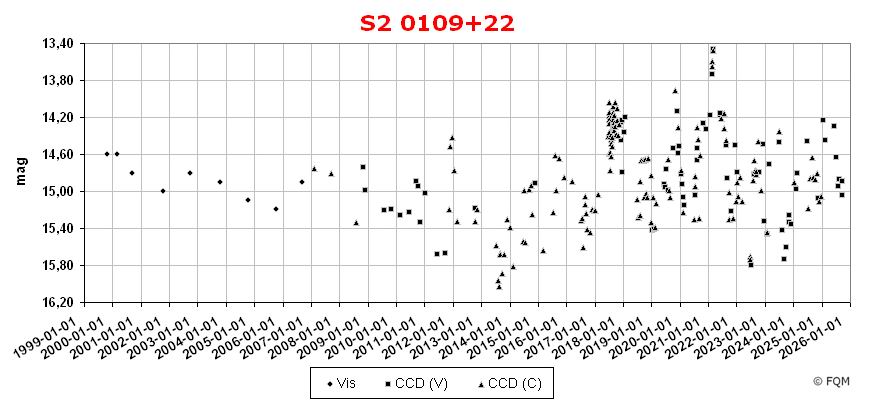
| Frankfurt Quasar Monitoring |
| S2 0109+22 |
| Cross-Identifications | GC 0109+22, TXS 0109+224, QSO B0109+224 PKS 0109+224, GB6 B0109+2228, 0109+224 1RXS J011205.2+224452, RX J0112.0+2244 87GB 010923.5+222858, RGB J0112+227 2E 0109.3+2228, 0FGL J0112.1+2247 |
| Equat. coordinates | RA 01 12 05.8 DE +22 44 39 (J2000) |
| Constellation | Pisces |
| Type | BL Lac |
| Redshift (2) | z=0.265 |
| Distance (2) (3) | 1023 Mpc |
| Total mag range (mv) (4) | 13.86 - 18.08 |
| Catalog Magnitude (1) | 15.66 |
| Absolute Magnitude (1) | --- MB |
| Light Travel-Time (2) | 2.968 × 109 yrs |

Comparison stars
| star | B | V | Rc | Ic |
| A | 12.142 | 11.582 | --- | --- |
| B | 13.251 | 12.511 | 12.111 | 11.761 |
| C | 14.042 | 13.372 | --- | --- |
| D | 14.902 | 14.152 | --- | --- |
| E | 15.191 | 14.451 | 14.091 | --- |
| F | 16.301 | 15.281 | 14.721 | 14.221 |
| G | 16.211 | 15.291 | 14.941 | 14.601 |
| H | 16.022 | 15.472 | --- | --- |
| I | 16.322 | 15.752 | --- | --- |

 Credit: SDSS /
Size 3´× 3´
This
image shows the
star-like host galaxy of S2 0109+22 |
 Credit: Nilsson et
al. (2003) / Size 26.6" × 26.6"
R-band
image by the Nordic Optical Telescope (image
inverted) |

| The BL Lac
object S2 0109+22 is
a strong radio source in northern Pisces, located between the two stars
Phi (85) Psc and Chi (84) Psc. The designation S2 0109+22
refers to the 2. Strong Source Catalog (S2),
where this object was discovered as a radio source in the late 1960s.
Since then, it has been catalogued by various other radio surveys. In
1976, the optical counterpart of this radio
source was identified with a stellar
object of 15.5 mag. Follow-up spectroscopic
investigations revealed a continuous spectrum. Together with the strong
optical polarization, S2 0109+22 was classified
as a BL Lac-type object. It was not until 2008 when the first accurate
redshift was published.
The new redshift of z=0.265 corresponds to a light travel time of about
3 Gyrs. Besides the optical and radio, S2 0109+22 has been detected as a source of both
X-ray and gamma emissions too. The most interesting feature about S2 0109+22 is its large optical variability of more than 4 magnitudes. On average, the brightness ranges between about 14.8 mag and 15.4 mag. Visual observers will recognize S2:0109+22 as a stellar object. At maximum brightness, telescopes of 8- to 10-inch of aperture are fine, but usually observers need an aperture of 12- to 14-inches or larger to detect this BL Lac object in the eyepiece. ____________
Right
next to S2
0109+22, only 6´ to the WSW, observers may like to test their skills
with double star WDS 01117+2243 (= COU 147 = TYC 7.58-mag). This tight double consists
of a
7.1-mag primary and an 11.8-mag companion, separated by a challenging
3.4". You find the WDS-double at the position of the
7.58-mag star in the lower right of the finding chart. Deep sky observers find two bright face-on spirals in the near vicinity: The showpiece galaxies M 74 (9.0° SE) and M:33 (9.4° NE). Those observers who like to focus on more very old quasi-stellar photons may turn to quasar I Zw 1, a bright 14-mag object at a distance of about 0.7×109 light-years, 11° SE of S2 0109+22. |
| Ciprini, S., Tosti, G., et al. 2003, A&A, 400, 487; Optical variability of the BL Lacertae object GC 0109+224. Falomo, R., Scarpa, R., et al. 1994, ApJS, 93, 125; Optical Spectrophotometry of Blazars. Karge, S.; Helle Quasare für 8- bis 10-Zoll Teleskope. Ein Beobachtungsführer zur visuellen Beobachtung von Quasaren und BL Lacertae Objekten; Frankfurt 2005. Katajainen, S., Takalo, L.O., et al. 2000, A&AS, 143, 357; Tuorla quasar monitoring. I. Observations of 1995-1997. Miller, H.R., Mullikin, T.L., et al. 1983, AJ, 88, 1301; Photoelectric comparison sequences in the fields of four BL Lacertae objects. Nilsson, K., Pursimo, T., et al. 2003, A&A, 400, 95; R-band imaging of the host galaxies of RGB BL Lacertae objects. Owen, F.N., Mufson, S.L. 1977, AJ, 82, 776; Extragalactic sources with strong Millimeter-Wave Emission. Pica, A.J. 1977, AJ, 82, 12; Optical and radio properties of a newly discovered BL Lac object. Pica, A.J., Pollock, J., Smith, A., et al. 1980, AJ, 85, 1442; Long-term optical behavior of 114 extragalactic sources. Pica, A.J., Smith, A.G., et al. 1988, AJ, 96, 4; Long-term optical behavior of 144 compact extragalactic objects: 1969-1988. Puschell, J.J., Stein, W.A. 1980, ApJ, 237, 331; Observations of strongly polarized extragalactic sources. Steinicke, W.; Katalog heller Quasare und BL Lacertae Objekte; Umkirch 1998. Villata, M., Raiteri, C.M., et al. 1997, A&AS, 121, 119; Optical photometric monitoring of gamma-ray loud blazars. I. Wills, B.J., Wills, D. 1979, ApJS, 41, 689; Spectroscopy of 125 QSO Candidates and Radio Galaxies. Véron-Cetty, M.-P., Véron, P. 2001, A&A 374, 92; A Catalogue of Quasars and Active Nuclei: 10th edition. Véron-Cetty, M.-P., Véron, P. 2003, A&A 412, 399; A Catalogue of Quasars and Active Nuclei: 11th edition. Véron-Cetty, M.-P., Véron, P. 2006, A&A 455, 776; A Catalogue of Quasars and Active Nuclei: 12th edition. Véron-Cetty, M.-P., Véron, P. 2010, A&A 518, 10; A Catalogue of Quasars and Active Nuclei: 13th edition. Xie, G.Z., Li, K.H., et al. 1992, ApJS, 80, 683; CCD Photometry of 14 BL Lacertae objects and theoretical model. |
| Links: Landessternwarte Heidelberg Chara/PEGA AAVSO Sloan Digital Sky Survey |
| home |